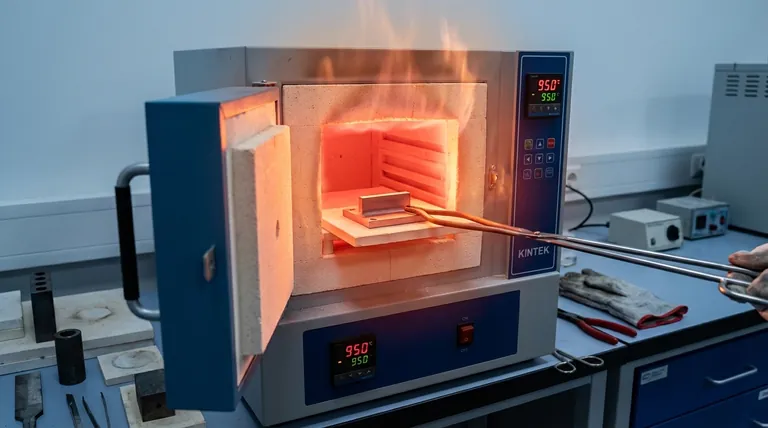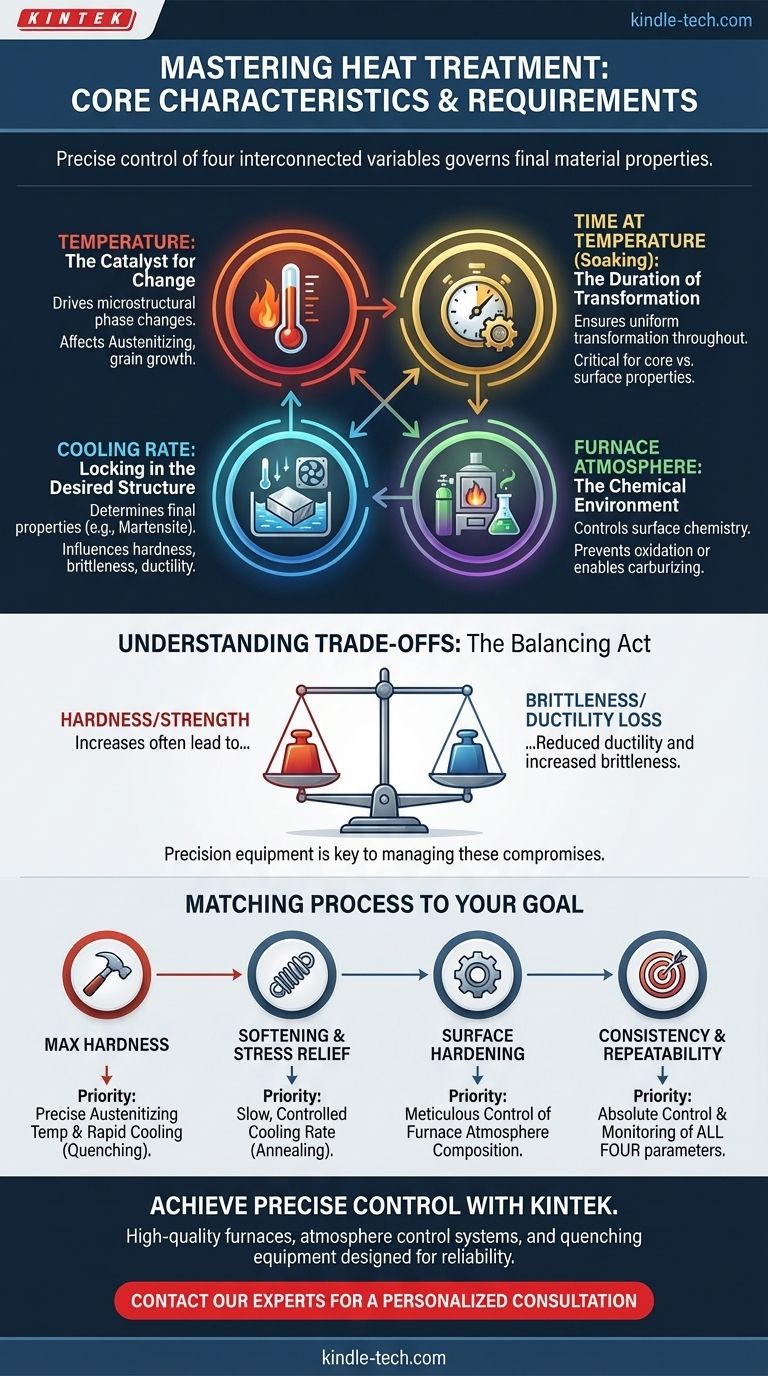To achieve specific material characteristics through heat treatment, you must precisely control four fundamental requirements: the heating temperature, the time the material is held at that temperature, the rate of cooling, and the chemical composition of the furnace atmosphere. These factors are not independent settings but interconnected variables that collectively govern the final physical and chemical properties of the material.
The success of any heat treatment process hinges on one core principle: controlled manipulation of a material's internal microstructure. The requirements are simply the levers we use to predictably drive that atomic-level change to produce a desired outcome like hardness, softness, or strength.

The Core Pillars of Heat Treatment Control
To understand heat treatment is to understand how each core requirement influences the final product. Altering any one of these can lead to a dramatically different outcome, which is why precision is paramount for repeatability.
H3: Temperature: The Catalyst for Change
Temperature is the primary driver of heat treatment. It provides the thermal energy needed to force changes in the material's crystal structure, also known as its phase.
Reaching a specific austenitizing temperature, for example, is necessary to dissolve elements like carbon into the iron matrix of steel, setting the stage for subsequent hardening. Insufficient temperature means the transformation will not occur, while excessive temperature can permanently damage the material by causing unwanted grain growth.
H3: Time at Temperature (Soaking): The Duration of Transformation
Material transformations are not instantaneous. Once the target temperature is reached, the material must be held there for a specific period, a process known as soaking.
This duration allows the thermal and chemical changes to occur uniformly throughout the entire part. A short soaking time might only transform the surface, leaving the core unaffected, while an excessively long time can be inefficient and contribute to issues like grain growth.
H3: Cooling Rate: Locking in the Desired Structure
The speed at which a material is cooled from its treatment temperature is arguably the most critical factor in determining its final properties, especially in steels.
A rapid cooling rate (quenching) traps the material's crystal structure in a hard, brittle state like martensite. Conversely, a slow, controlled cooling rate (annealing) allows the structure to rearrange into a soft, ductile state. The cooling method dictates whether you produce a file or a paperclip from the same starting steel.
H3: Furnace Atmosphere: The Chemical Environment
The atmosphere inside the furnace controls the chemical reactions that occur on the material's surface at high temperatures.
An inert atmosphere (like argon or nitrogen) is used to prevent oxidation or scaling. An active atmosphere, however, is intentionally used to alter the surface chemistry. Processes like carburizing or carbonitriding use atmospheres rich in carbon or nitrogen to create a hard, wear-resistant surface layer on a softer core.
Understanding the Trade-offs
Heat treatment is a balancing act. Improving one property often comes at the expense of another. Understanding these compromises is essential for making sound engineering decisions.
H3: Hardness vs. Brittleness
This is the most fundamental trade-off. Processes that dramatically increase hardness, such as quenching steel to form martensite, also significantly increase its brittleness. A fully hardened, as-quenched part is often too brittle for practical use, which is why a secondary heat treatment like tempering is required to restore some toughness.
H3: Strength vs. Ductility
Increasing a metal's tensile strength typically reduces its ductility—its ability to deform or stretch without fracturing. The choice of heat treatment process depends entirely on whether the application requires the material to resist being pulled apart or to bend without breaking.
H3: Precision vs. Cost
Achieving highly repeatable and precise results demands sophisticated equipment capable of tightly controlling all four core requirements. Vacuum furnaces with controlled atmospheres and programmable cooling cycles deliver superior results but come at a much higher operational cost than simple air furnaces used for general annealing or stress relieving.
Matching the Process to Your Goal
The right combination of requirements is dictated entirely by your end goal. Use this as a guide to prioritize your focus.
- If your primary focus is maximum hardness: Precise control over reaching the correct austenitizing temperature and ensuring a sufficiently rapid cooling rate (quenching) are the most critical factors.
- If your primary focus is softening and stress relief: The key requirement is a slow, controlled cooling rate from a specific annealing or stress-relieving temperature.
- If your primary focus is surface hardening: The single most important requirement is meticulous control of the furnace atmosphere's chemical composition to infuse elements into the part's surface.
- If your primary focus is consistency and repeatability: Absolute control and diligent monitoring of all four parameters—temperature, time, cooling rate, and atmosphere—are non-negotiable.
Mastering these requirements transforms heat treatment from a simple procedure into a predictable engineering tool.
Summary Table:
| Requirement | Key Role | Influences |
|---|---|---|
| Temperature | Drives microstructural phase changes | Austenitizing, grain growth |
| Time (Soaking) | Ensures uniform transformation throughout the part | Core vs. surface properties, efficiency |
| Cooling Rate | Locks in the final microstructure (e.g., martensite) | Hardness, brittleness, ductility |
| Furnace Atmosphere | Controls surface chemistry (prevents oxidation or enables carburizing) | Surface hardness, wear resistance |
Achieve precise control over your heat treatment processes with KINTEK.
Whether you are hardening tool steel, annealing copper, or carburizing gears, the right lab equipment is crucial for controlling temperature, time, atmosphere, and cooling rate. KINTEK specializes in high-quality furnaces, atmosphere control systems, and quenching equipment designed for reliability and repeatability.
Let us help you select the perfect equipment to meet your specific material goals, improve consistency, and reduce costs. Contact our experts today for a personalized consultation!
Visual Guide

Related Products
- 1700℃ Muffle Oven Furnace for Laboratory
- High Temperature Muffle Oven Furnace for Laboratory Debinding and Pre Sintering
- Laboratory Rapid Thermal Processing (RTP) Quartz Tube Furnace
- 1700℃ Laboratory High Temperature Tube Furnace with Alumina Tube
- Graphite Vacuum Furnace High Thermal Conductivity Film Graphitization Furnace
People Also Ask
- What is the difference between a muffle furnace and a normal furnace? Ensuring Sample Purity with Indirect Heating
- Why is a laboratory high-temperature muffle furnace required for the post-annealing treatment of copper oxide?
- What is done by ashing in muffle furnace? A Guide to Precise Inorganic Content Analysis
- What is the difference between muffle furnace and air oven? Choose the Right Tool for Your Thermal Process
- What is the difference between a box furnace and a muffle furnace? Choose the Right Lab Furnace for Your Application



















